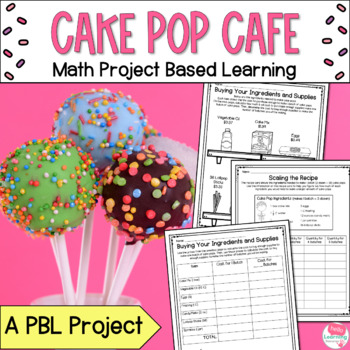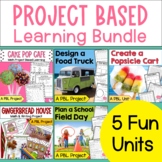Project Based Learning Math | Math PBL Cake Pop Cafe
- PDF
What educators are saying
Also included in
- Your students will love working on the real world math project based learning units included in this bundle! Use these PBL math projects as authentic assessments, end of unit activities or as fun multi-disciplinary units. Perfect for 4th and 5th grade!Save 25% off the price of the individual resourPrice $19.97Original Price $26.15Save $6.18
Description
This project based learning math unit will keep students engaged in learning while working on a real world math project! This pbl math project applies math skills to the real life situation of setting up a cake pop cafe.
Please click on the green PREVIEW button above to see more details of what is included in this PBL resource.
This math pbl unit is broken up into 7 sections:
- 1- Set Up Your Business - students decide on a name and location for their cafe then design a logo and their cafe building.
- 2- Cake Pop Flavors - students choose cake pop flavor combinations and determine how many batches and total cake pops they will make.
- 3- Cake Pop Recipe - students will use a recipe for one batch of cake pops and scale it up to create multiple batches.
- 4- Buying Ingredients - students calculate the price to buy supplies for one batch of cake pops and the cost for multiple batches.
- 5- Daily Schedule - students will use a list of steps and the time each step takes to calculate elapsed time and how much time it will take to create their cake pops.
- 6- Menu - Students determine the cost per unit, decide on selling prices to make a profit, choose additional items to round out their menu and design a colorful menu for their business.
- 7- Cake Pop Themed Math Skill Sheets - This section includes cake pop themed skill sheets to practice creating combinations, multiplication, word problems and finding fractions of a set.
Skills Included:
- adding fractions
- adding decimals
- multiplying fractions
- multiplying decimals
- scaling a recipe
- elapsed time
- combinations
- cost per unit
- selling price and profit
- word problems
- fractions of a set
- multiplication (3 digit by 1 digit and 2 digit by 1 digit)
- creativity
Also included:
- Detailed teacher directions for each section including supplies, procedures, discussion questions and differentiation ideas.
- Student reflection and peer feedback sheets
- Grading rubric - easy to use rubric to grade student menu creations
- Extension ideas
- Entry event ideas to kick off the math project based learning unit
- Answer keys
Estimated time to complete this project based learning unit : 5-6 days, depending on how much time you spend each day, and whether or not you do all of the components.
You may also like my:
Design a Dream Bedroom Project
Geometry City Angles and Lines Project
Create a Popsicle Cart Math PBL
Winter Project Based Learning | Gingerbread House Math
Follow me and be notified when new products are added to my store. New products are always 50% off for the first 24 hours they are posted!
Thank you!
-Dawn






